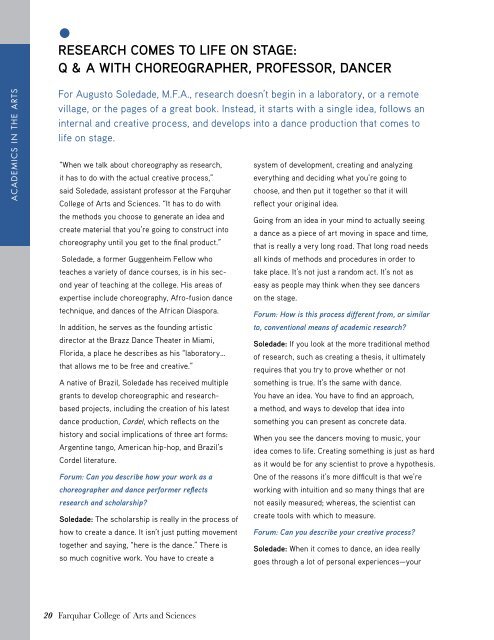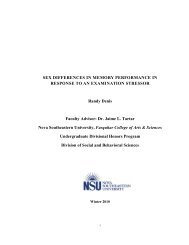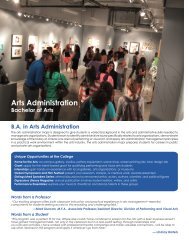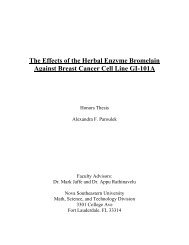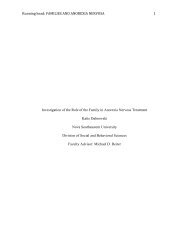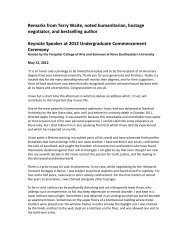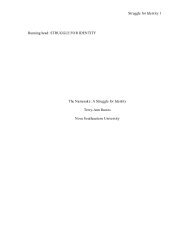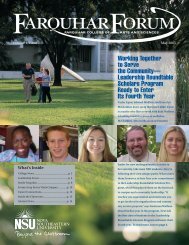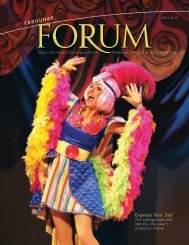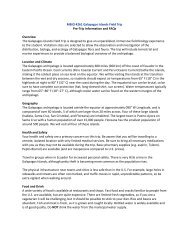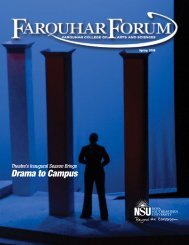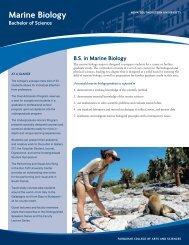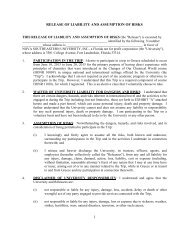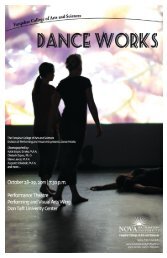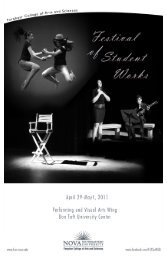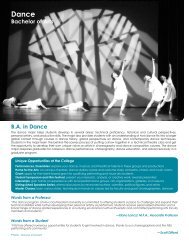2012â2013 - College of Arts and Sciences - Nova Southeastern ...
2012â2013 - College of Arts and Sciences - Nova Southeastern ...
2012â2013 - College of Arts and Sciences - Nova Southeastern ...
You also want an ePaper? Increase the reach of your titles
YUMPU automatically turns print PDFs into web optimized ePapers that Google loves.
Research cOMES to Life on Stage:<br />
Q & A with Choreographer, Pr<strong>of</strong>ESSOR, Dancer<br />
ACADEMICS IN THE ARTS<br />
For Augusto Soledade, M.F.A., research doesn’t begin in a laboratory, or a remote<br />
village, or the pages <strong>of</strong> a great book. Instead, it starts with a single idea, follows an<br />
internal <strong>and</strong> creative process, <strong>and</strong> develops into a dance production that comes to<br />
life on stage.<br />
“When we talk about choreography as research,<br />
it has to do with the actual creative process,”<br />
said Soledade, assistant pr<strong>of</strong>essor at the Farquhar<br />
<strong>College</strong> <strong>of</strong> <strong>Arts</strong> <strong>and</strong> <strong>Sciences</strong>. “It has to do with<br />
the methods you choose to generate an idea <strong>and</strong><br />
create material that you’re going to construct into<br />
choreography until you get to the final product.”<br />
Soledade, a former Guggenheim Fellow who<br />
teaches a variety <strong>of</strong> dance courses, is in his second<br />
year <strong>of</strong> teaching at the college. His areas <strong>of</strong><br />
expertise include choreography, Afro-fusion dance<br />
technique, <strong>and</strong> dances <strong>of</strong> the African Diaspora.<br />
In addition, he serves as the founding artistic<br />
director at the Brazz Dance Theater in Miami,<br />
Florida, a place he describes as his “laboratory…<br />
that allows me to be free <strong>and</strong> creative.”<br />
A native <strong>of</strong> Brazil, Soledade has received multiple<br />
grants to develop choreographic <strong>and</strong> researchbased<br />
projects, including the creation <strong>of</strong> his latest<br />
dance production, Cordel, which reflects on the<br />
history <strong>and</strong> social implications <strong>of</strong> three art forms:<br />
Argentine tango, American hip-hop, <strong>and</strong> Brazil’s<br />
Cordel literature.<br />
Forum: Can you describe how your work as a<br />
choreographer <strong>and</strong> dance performer reflects<br />
research <strong>and</strong> scholarship?<br />
Soledade: The scholarship is really in the process <strong>of</strong><br />
how to create a dance. It isn’t just putting movement<br />
together <strong>and</strong> saying, “here is the dance.” There is<br />
so much cognitive work. You have to create a<br />
system <strong>of</strong> development, creating <strong>and</strong> analyzing<br />
everything <strong>and</strong> deciding what you’re going to<br />
choose, <strong>and</strong> then put it together so that it will<br />
reflect your original idea.<br />
Going from an idea in your mind to actually seeing<br />
a dance as a piece <strong>of</strong> art moving in space <strong>and</strong> time,<br />
that is really a very long road. That long road needs<br />
all kinds <strong>of</strong> methods <strong>and</strong> procedures in order to<br />
take place. It’s not just a r<strong>and</strong>om act. It’s not as<br />
easy as people may think when they see dancers<br />
on the stage.<br />
Forum: How is this process different from, or similar<br />
to, conventional means <strong>of</strong> academic research?<br />
Soledade: If you look at the more traditional method<br />
<strong>of</strong> research, such as creating a thesis, it ultimately<br />
requires that you try to prove whether or not<br />
something is true. It’s the same with dance.<br />
You have an idea. You have to find an approach,<br />
a method, <strong>and</strong> ways to develop that idea into<br />
something you can present as concrete data.<br />
When you see the dancers moving to music, your<br />
idea comes to life. Creating something is just as hard<br />
as it would be for any scientist to prove a hypothesis.<br />
One <strong>of</strong> the reasons it’s more difficult is that we’re<br />
working with intuition <strong>and</strong> so many things that are<br />
not easily measured; whereas, the scientist can<br />
create tools with which to measure.<br />
Forum: Can you describe your creative process?<br />
Soledade: When it comes to dance, an idea really<br />
goes through a lot <strong>of</strong> personal experiences—your<br />
20 Farquhar <strong>College</strong> <strong>of</strong> <strong>Arts</strong> <strong>and</strong> <strong>Sciences</strong>


